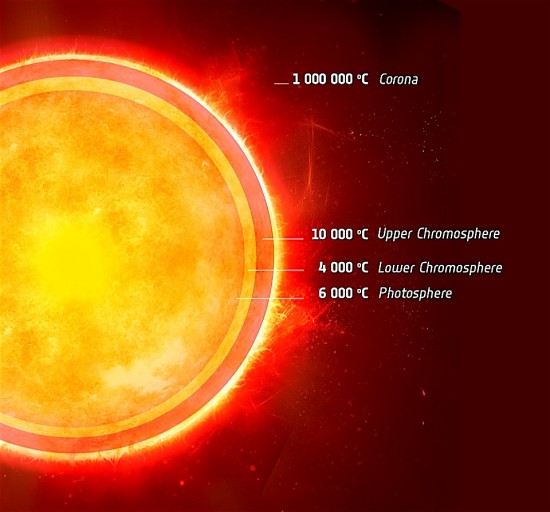
Artist’s impression of double layers surrounding Alpha Centauri. Credit: ESA
Note: The Picture of the Day will be on hiatus until December 26, 2018. In the interim, please enjoy these articles from the archive.
Dec 21, 2018
The Sun’s activity remains mysterious.
Among heliophysicists it is commonly thought that the Sun accelerates charged particles into space in the same way that sound waves are amplified. Solar energy is said to travel outward from the interior through “acoustical wave-guides”, known as magnetic flux tubes. Spicules form above the photosphere, carrying the hot gas with them.
As standard theories about the Sun propose, there is also a vast “conveyor belt” circulating solar matter down into magnetically active zones deep inside the solar interior. When sunspot magnetic fields begin to decline, the conveyor belt pulls what’s left inside the Sun. This is speculation, however.
According to a recent press release, the electromagnetic nature of the Sun remains obscure. As Tim Horbury of Imperial College wrote: “We don’t know how the Sun’s magnetic cycle works.”
Plasma discharge phenomena are a better model for solar activity, which is why astronomers have a difficult time explaining the Sun’s behavior. Laboratory experiments with a positively charged sphere show that a plasma torus forms above its equator. Electric discharges bridge the torus with the middle and lower latitudes of the sphere. Spicules are consistent with the principle of “anode tufting,” a plasma discharge effect expected of an electronic Sun.
Sunspots appear when electric discharges penetrate the photosphere, allowing electric charge to flow into its depths. Electromagnetic flux tubes expose the Sun’s cooler interior. The idea of acoustic heat transfer from the core cannot be supported by any observations.
Sunspots are also not well understood when considered from the standpoint of a nuclear powered Sun. It is known that magnetism is somehow involved with sunspot activity, because gigantic loops of plasma can often be seen connecting two or more of them. Filaments and “fibrils” can be detected with high resolution photographic equipment in the penumbra, or darkened cores of sunspots. The swirling plasma spirals look like electromagnetic tornadoes, although fluid dynamic activity does not apply to the Sun.
This is where understanding the difference between hot gas (which does not contain charged particles) and plasma (which does contain charged particles and can be electrically active) could provide some illumination: sunspots are not the result of gas convection modified by magnetism, sunspots are electrical structures.
Sunspot images indicate that they are charge vortices. Looking down into a sunspot means seeing the rotating discharge columns in profile. Electric discharge in plasma forms hollow tendrils: “funnels” of plasma with dark centers. Convection cells, on the other hand, would appear darker at their edges. If the Sun is a nuclear fusion furnace, with all energy generation taking place in its core, then its interior should be brighter and hotter. Standard theory does not accept that the darker regions revealed by sunspots means that the Sun is cooler in its interior.
Multiple loop structures connect sunspots and rise up to penetrate the chromosphere. The chromosphere is a plasma sheath, or double layer region on the Sun, where most of its electric charge is contained. When the charges flowing into the Sun’s plasma sheath increase beyond a critical threshold, a sudden release of that energy occurs, causing solar flares and enormous prominence eruptions.
When charge accumulation grows too strong, the plasma double layer is destroyed. That event interrupts the charge flow and the stored electromagnetic energy is blasted into space as a solar flare. Solar flares can therefore be thought of as lightning bolts in and on the Sun, sometimes throwing vast quantities of matter into space at near relativistic speeds.
“In a low density plasma, localized space charge regions may build up large potential drops…Such regions have been called electric double layers…In the laboratory, double layers have been studied for half a century, but their importance in cosmic plasmas has not been generally recognized.” (Hannes Alfvén)
Stephen Smith












